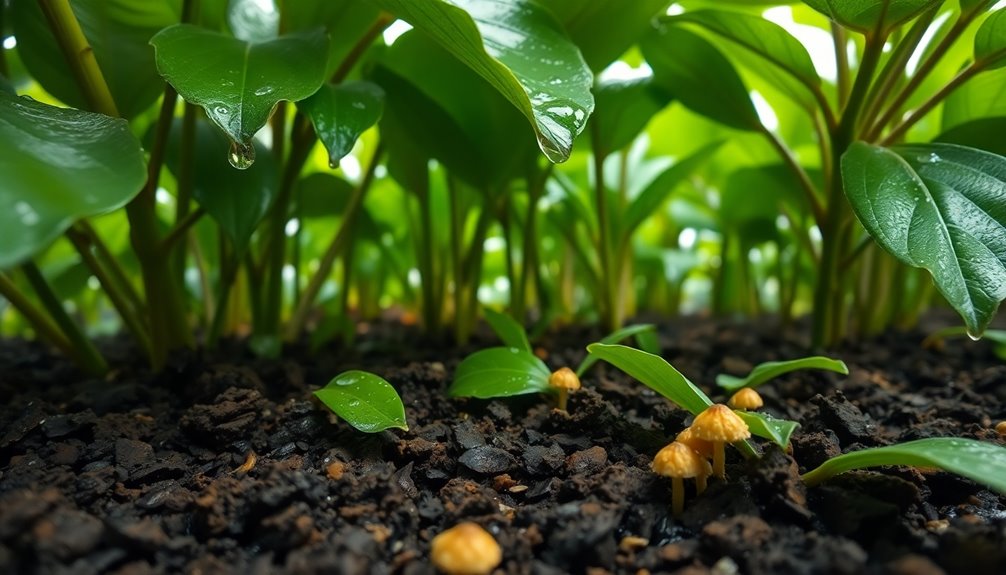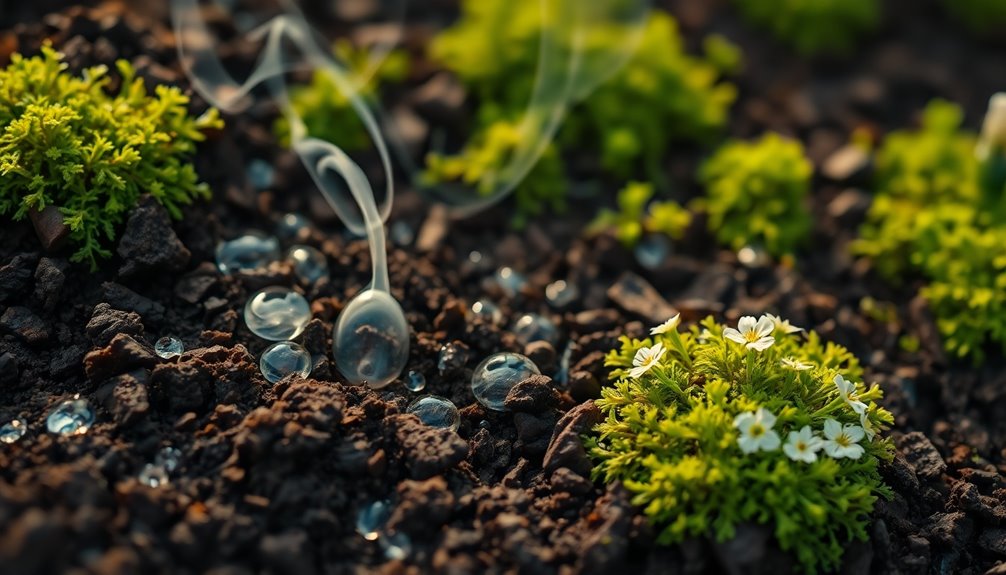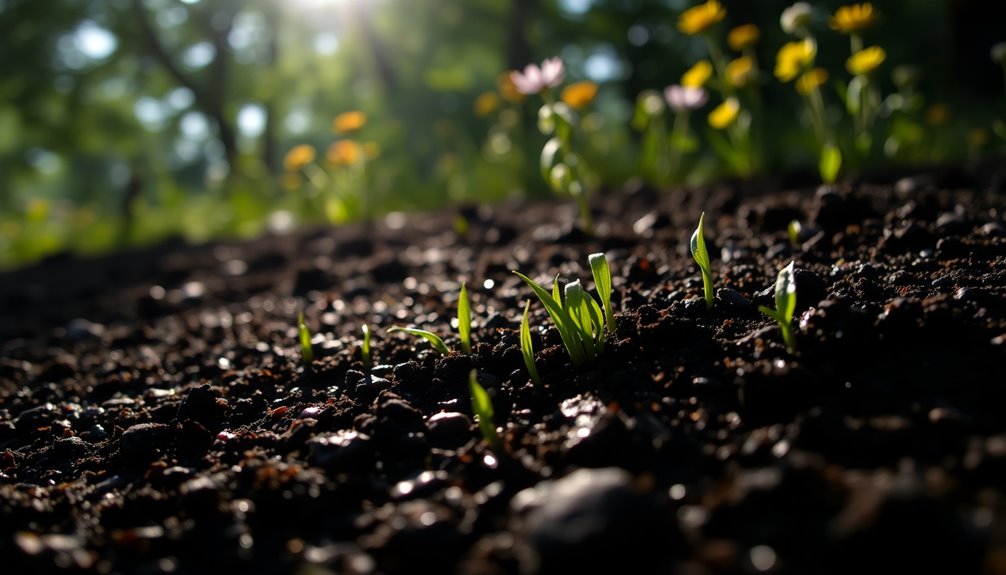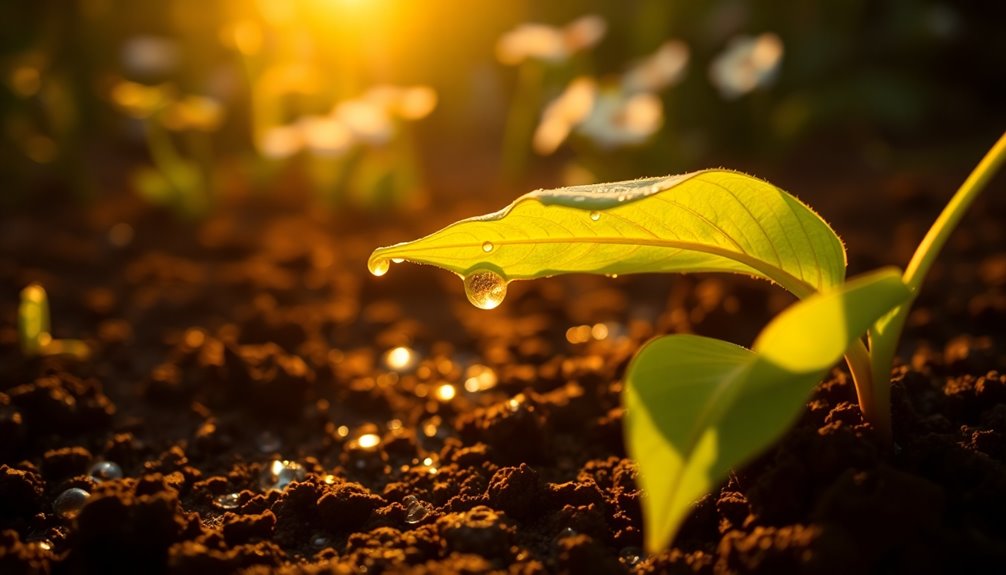Geosmin smells earthy and musty, like freshly turned soil after a rain. You might recognize this scent when walking through a garden or after a good downpour. This unique aroma is produced by soil bacteria and fungi, especially in moist environments. Many find it pleasant, as it evokes memories of nature and renewal. You can even detect it in some foods, like mushrooms and beets. It's fascinating how this compound plays a role in our sensory experiences and environmental health. If you're curious about its other impacts and significance, you'll want to keep exploring.
Key Takeaways
- Geosmin has a distinct earthy and musty aroma, reminiscent of freshly turned soil.
- It is often associated with the pleasant smell of petrichor after rainfall.
- The scent evokes nostalgia linked to rain-soaked earth and nature.
- Geosmin can be detected by humans at very low concentrations, down to 5-10 parts per trillion.
- Many people find the smell of geosmin comforting and pleasant, despite individual sensitivity variations.
Introduction

Geosmin, with its distinct earthy smell, is something you've likely encountered, especially after a refreshing rain. This unique aroma is a product of soil bacteria, particularly actinomycetes, cyanobacteria, and certain fungi. When rainwater hits the ground, it releases geosmin into the air, contributing to that delightful petrichor scent you may find invigorating.
You might be surprised to learn that humans can detect geosmin at incredibly low concentrations, ranging from just 0.4 parts per billion to an astonishing 5 parts per trillion. This heightened sensitivity is part of what makes the earthy smell so recognizable, even if it's faint. Geosmin doesn't just linger in the air; it's also found in some foods, like fresh beets, where it adds an earthy flavor that many people enjoy.
In addition, certain fish and vegetables carry the essence of geosmin, enriching your culinary experiences. Understanding geosmin's role helps you appreciate how connected we are to the natural world around us, giving us a deeper sensory experience every time you breathe in that refreshing, earthy smell.
Description of the Smell

The earthy and musty odor of geosmin often evokes memories of freshly turned soil or the refreshing scent that follows a rainstorm. This distinctive smell is a key element of petrichor, the delightful aroma that arises when rain hits dry ground. You might notice that geosmin's scent lingers in the air, wrapping around you like a comforting embrace, especially after a long-awaited rain.
What's fascinating is that you can detect geosmin at incredibly low concentrations, sometimes as little as 0.4 parts per billion. This sensitivity makes the earthy odors of geosmin particularly pronounced, even in small amounts. While it's often associated with nature, geosmin also finds its way into food, especially in items like beets, which carry its unique earthy taste.
However, not everyone appreciates this smell. In aquaculture, for instance, geosmin can impart undesirable off-flavors to fish, affecting your perception of quality. Overall, the smell of geosmin, with its rich and earthy notes, is a powerful reminder of nature's influence on our senses and experiences.
Source and Composition

A distinctive earthy aroma often fills the air after rainfall, and this scent originates from geosmin, a bicyclic terpene. You might not realize it, but the smell of geosmin is produced by various microorganisms, primarily soil bacteria called Actinomycetes. These bacteria synthesize geosmin through specific biochemical pathways, releasing it into the atmosphere when soil is disturbed, such as during rainfall. The raindrops create air pockets that help release this volatile compound, allowing you to experience that rich, earthy taste.
Interestingly, geosmin is detectable by humans at incredibly low concentrations—just 5 parts per trillion! This strong olfactory presence is also why you may notice the smell of geosmin in water treatment processes, as it can affect the quality of drinking water when present. The earthy scent is closely tied to natural phenomena, often appearing as spring ephemerals bloom after rain, creating a delightful connection between nature and the sensory experiences you enjoy. So next time you catch that fresh, earthy aroma, remember that it's the result of tiny microorganisms working their magic in the soil.
Typical Scenarios or Environments

After a fresh rain, you might find yourself stepping outside to savor the earthy aroma that envelops the landscape, a scent often attributed to geosmin. This distinctive smell can be particularly strong in agricultural environments, where freshly tilled soil releases geosmin, enhancing the sweet, rich fragrance of the land.
You may also notice this musty aroma in freshwater environments, such as lakes and rivers. During warm seasons, algal blooms can amplify the presence of geosmin, making the smell more pronounced as you stroll by the water's edge.
As you prepare certain foods, like beets and mushrooms, the earthy smell of geosmin can fill your kitchen, reminding you of the natural world. Even when enjoying a glass of wine, you might detect subtle hints of geosmin, which can impart a unique character to the beverage.
In each of these scenarios, geosmin plays a vital role in shaping the sensory experience. Whether you're in nature or at home, the earthy smell of geosmin connects you to the environment, evoking a sense of place that can be both grounding and refreshing.
Emotional or Cultural Associations

Nostalgia often washes over you when you catch a whiff of geosmin, a scent that evokes memories of rain-soaked earth and lush landscapes. This earthy aroma connects you to nature, reminding you of moments spent outdoors. It's no wonder that geosmin plays a significant role in the cultural phenomenon of petrichor, a term that encapsulates the joy of rain on dry soil.
In various cultures, the smell of geosmin symbolizes agricultural fertility and the rejuvenation of the earth. It signifies growth and renewal, resonating with seasonal changes that bring life back to the landscape. When you breathe in that familiar scent, you might think of gardening, hiking, or simply enjoying a rainy day. These moments reinforce its importance as a marker of natural beauty and tranquility.
Geosmin's earthy fragrance often finds its way into literature and art, representing grounding themes of authenticity and simplicity. You might feel a sense of comfort or connection to your roots when you encounter it. Ultimately, geosmin isn't just a smell; it's an emotional and cultural touchstone that celebrates life and the beauty of the natural world.
Health or Safety Considerations

When working with geosmin, it's crucial to keep safety in mind due to its potential hazards. Geosmin is classified as a category 2A substance for serious eye damage, meaning it can cause significant harm if it comes into contact with your eyes. The hazard statement H319 clearly indicates this risk, emphasizing the need for safety measures.
Because of geosmin's volatile nature, it can easily become aerosolized, increasing the risk of inhalation or eye contact, particularly in enclosed workspaces. To protect yourself, ensure you're wearing appropriate personal protective equipment, such as goggles and masks, when handling this compound.
Proper labeling of geosmin containers is also essential for maintaining safety. Make sure to stay informed about its hazards and follow all safety protocols in both research and industrial settings. This awareness can prevent accidents and ensure a safer environment for everyone involved.
Final Thoughts

Understanding geosmin's unique properties and its impact on both our environment and sensory experiences can enhance your appreciation for this fascinating compound. This distinct earthy smell, reminiscent of freshly turned soil or the comforting scent after rainfall, plays a significant role in how you connect with nature.
Humans have an incredible ability to detect geosmin at incredibly low concentrations, with sensitivity ranging from just 0.4 parts per billion to as low as 5 parts per trillion. This remarkable sensitivity allows us to experience the earthy aroma associated with specific conditions, especially during spring when rain or soil disturbance releases it into the air.
Moreover, geosmin also enhances the aroma of petrichor, enriching your sensory experience of wet earth and its rejuvenating qualities. You might even notice its presence in certain foods, like beets, where high levels of this compound contribute to their unique flavor profile.
Ultimately, geosmin serves as a reminder of our deep connection to the environment. By recognizing and appreciating this earthy smell, you can cultivate a greater awareness of the natural world around you.
Frequently Asked Questions
Does Geosmin Smell Good?
You might find that geosmin smells good, especially if you enjoy earthy, natural scents. Many people appreciate its aroma, often likening it to fresh soil or the refreshing scent after rain. This pleasant fragrance can evoke feelings of being outdoors and connected to nature. However, your perception could vary, especially if you encounter it in food or water, where it might be less appealing. Overall, the context plays a big role in how you perceive it.
What Is the Difference Between Petrichor and Geosmin?
Petrichor and geosmin are closely related but distinct. Geosmin's an earthy compound produced by soil bacteria, while petrichor is the complex aroma that arises when rain hits dry soil. It combines geosmin with plant oils released during dry periods. So, when you smell that refreshing scent after a rain shower, you're experiencing petrichor, which you can thank geosmin and those plant oils for creating a delightful sensory experience.
What Is the Smell When It First Rains?
When it first rains, you often notice a fresh, earthy scent filling the air. This aroma, known as petrichor, arises from a combination of plant oils and compounds released from the soil. As raindrops hit the ground, they create tiny aerosols that carry these scents upward, making the smell even more noticeable. You might find this fragrance comforting, as it signals a refreshing change in the environment, rejuvenating both the land and your senses.
What Is the Smell of Wet Earth Called?
The smell of wet earth is called petrichor. You might notice this refreshing, earthy scent after the first rain, especially following a dry spell. It's created when raindrops hit the soil, releasing compounds from soil-dwelling bacteria. If you take a deep breath, you can almost feel the cleanliness and renewal in the air. Petrichor's unique aroma often evokes memories of nature, making you appreciate the beauty of a fresh rainfall.









